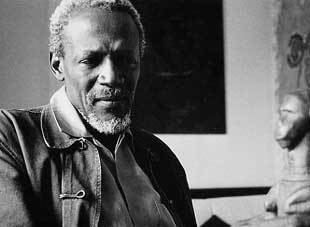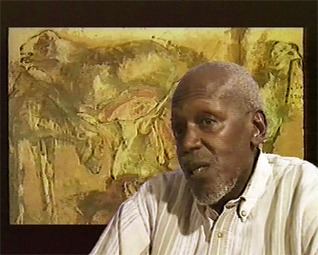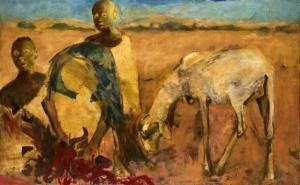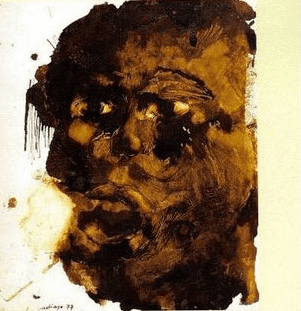Nationality SenegalFrance | ||
 | ||
Died 5 October 2008, Paris, France Education École nationale supérieure des Beaux-Arts People also search for Yves Bergeret, Hervé Bacquet, Iba Ndiaye Diadji, Abdou Sylla | ||
Street lourd iba n diaye
Iba N'Diaye (1928 – October 5, 2008) was a French-Senegalese painter. Trained in Senegal and France during the Colonial period, N'Diaye utilised European modernist fine arts training and medium to depict his views of African realities. He returned to Senegal upon its independence, and became the founding head of Senegal's national fine arts academy. Disenchanted with the prevailing artistic and political climate of mid 1960s Dakar, N'Diaye returned to France in 1967 and exhibited around the globe, returning to his birthplace of Saint-Louis, Senegal, to present his work in Senegal again only in 2000. N'Diaye died at his home in Paris in October, 2008 at age 80.
Contents
- Street lourd iba n diaye
- Interview avec monsieur iba n diaye 02
- Early life and training
- Return to Africa
- Exhibition history
- Work
- Notable works
- References

Interview avec monsieur iba n diaye 02
Early life and training

Born in Saint Louis, Senegal, when he was 15 years old began his studies at the prestigious Lycée Faidherbe. As a student he painted posters for cinemas and businesses in his town. He studied architecture in Senegal before traveling to France in 1948, where he began studying architecture at the École des Beaux-Arts in Montpellier. The sculptor Ossip Zadkine introduced him the traditional African sculpture, and he traveled throughout Europe, studying art and architecture. N'Diaye frequented jazz music clubs while in Paris in the 1940s, and his interest in the medium continues to show itself in his work. In Paris he studied fine art at the École des Beaux-Arts and Académie de la Grande Chaumière.
Return to Africa

When Senegal achieved independence in 1959, he returned at the request of President Léopold Senghor, to found the Department of Plastic Arts at the National School of Fine Arts of Senegal in Dakar. There he exhibited his work in 1962 and worked as a teacher until 1966. He taught and inspired a generation of fine artists, including painters such as Mor Faye.

N'Diaye, along with Papa Ibra Tall and Pierre Lods founded The Ecole de Dakar, a genre which allied painting, sculpture and crafts into the literary movement of Negritude: an attempt to assert a distinctively African voice in the arts, free of, if borrowing elements from, the traditions of colonial nations. "Africanité" (Africanness) combined the Negritude of Senghor and the Pan-Africanism of decolonialism. N'Diaye, though, remained committed to teach the fundamentals and techniques of Western art, at times putting him at odds with his fellow teachers and artists. He wrote of the danger of "Africanness" sliding back into a simplistic Noble savage self-parody if rejecting Western forms meant rejecting a rigorous technical background. The pursuit of this "instinctive" Africanness is best exemplified by Papa Ibra Tall, who felt that African artists must "unlearn" western habits, tapping instinctual African creativity. Tall and N'Diaye were the two best-known French-educated Senegalese fine artists of their time. While Tall's vision was to win out in the short term, the 1970s and 80s saw a reappraisal of N'Diaye's positions and an eventual rejection of the more straightforward state-sponsored "Africanité". President Senghor, as a poet one of the founders of Negritude, devoted as much as %25 of the Senegalese budget to the arts and was seen as the patron of artists like The Ecole de Dakar. Misgivings by artists like N'Diaye (as well as outright opposition by artists such as film-maker/author Ousmane Sembène) fed into a later creative break with Negritude, in the 1970s led by the Laboratoire Agit-Art art community in Dakar. N'Diaye's disenchantment and return to France in 1967 came just a year after the World Festival of Black Arts was founded in Dakar: a triumph of the "Africanité" arts.

N'Diaye died in Paris on October 4, 2008 at the age of 80 of heart failure. The Senegalese Ministry of Culture is coordinating his interment, beside his mother, in the Catholic cemetery of Saint-Louis, Senegal. Upon the artist's death, President of Senegal Abdoulaye Wade called N'Diaye the "Father-founder of Senegalese Modern Art."
Exhibition history

Working at his Parisian "la Ruche Atelier" and his home in the Dordogne, N'Diaye painted some of his best-known works, a series on the theme of the biblical ritual slaughter of a lamb: the "Tabaski" series, exhibiting them at Sarlat in 1970 and at Amiens in 1974.
N'Diaye exhibited his paintings in New York City (1981), in the Netherlands (1989); in 1990 in Tampere (1990), and at the Museum Paleis Lange Voorhout in The Hague (1996). In 1987 was the subject of a retrospective at the Museum für Völkerkunde in Munich. In 2000, he returned to Saint Louis for his first exhibition in Senegal since 1981. In 1977, he was the subject of a retrospective at the Musée Dynamique, while in 1981, his work was presented at the Centre culturel Gaston Berger de Dakar. Since that time major showing of his work was staged at the Senegalese Galerie nationale (2003) and the Musée de la Place du Souvenir (2008), both in the Senegalese capitol.
Work
Influenced equally by western Modernism and African tradition, one reviewer described him as "a Senegalese painter whose insistence that African artists can be whatever they want to be". His study of African sculpture has shown in his subjects, but treated in colors and mood reminiscent of abstract expressionism. Equally, Jazz musicians, painted in movement and swirls of color, have been a recurring theme in his work: his "Hommage à Bessie Smith" perhaps the best known.
